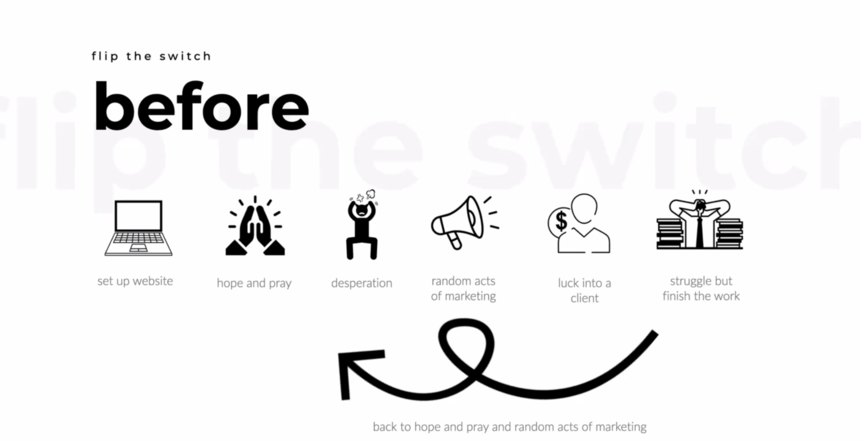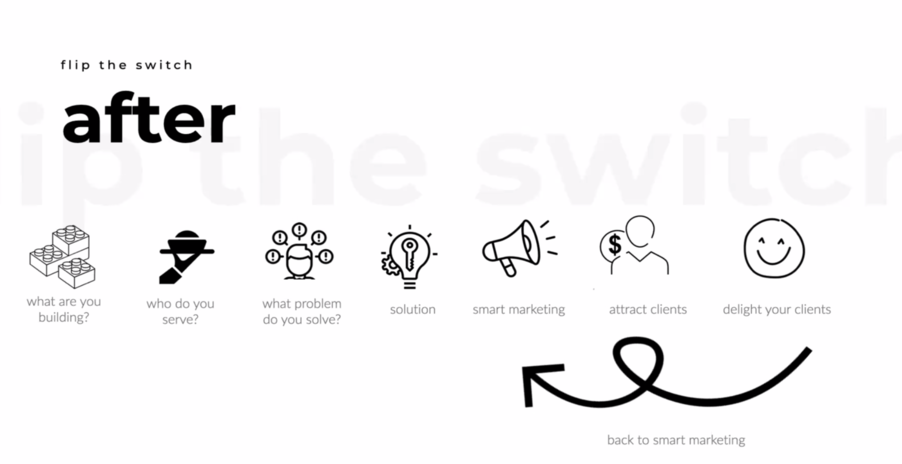If you’re a copywriter like me or someone who’s thinking of writing professionally, it’s easy to think of yourself as just a writer. You’re not. You’re a business owner. Someone who’s got to think about marketing, accounting, networking, partnering and all the other stuff business owners have to do to pay the bills.
Shifting your mindset from writer to writer AND business owner was the topic of The Copywriting Club’s Flip The Switch webinar. Hosted by Rob Marsh and Kira Hug, the webinar went over five critical moves you need to make to build a successful copywriting business.
Great advice and great writing philosophy followed.
Making the distinction between being a writer and business owner
In the webinar’s introduction, Marsh and Hug drilled down into the key differences between being a copywriter and owning a copywriting business. The feast or famine cycle is a common challenge in the freelance writing industry and you can see the differences in the slides below:


An interesting bit of copywriting philosophy Marsh pointed out was to view your writing as an operating system. He defined it as “an operating system is a set of concepts and processes that support the goals and objectives in your copywriting business and provides alignment between you, your team and your clients to solve real problems and create value.”
This led into five eye-opening business-orientated tips that can benefit both new and experienced freelance copywriters.
1. Nail your x-factor
When it comes to finding your x-factor in copywriting, it means knowing what sets you apart and how you are placed to solve a unique problem for clients. This isn’t the same as having a niche, which Marsh and Hug pointed out as only scratching the surface of what’s possible.
Finding your content marketing x-factor can involve creating two separate lists that apply to you and the businesses you want to work with. The first list is about your skills, your credentials, the jobs you’ve worked and any other multipliers that are relevant.
The second list should cover your ideal clients, the problems they need to solve, psychological needs etc. You can then combine these lists together and then figure out how you can solve a specific set of problems.
2. Know how to price yourself
Using the right pricing framework is crucial to creating a successful copywriting brand and the key takeaways from the webinar were:
- NEVER price by the word
- Charging by the hour isn’t recommended either as you’re sacrificing precious time
- Focus on charging for value and deliverables and get under the hood of what a potential client’s aims are. What metrics are they trying to increase? What are they turning over per year? Asking questions up front can tease out the value of your services.
3. Build your signature package
Making it as easy as possible for a client to purchase your content marketing services goes a long way. Hug and Marsh highlighted the way to do this is to build a signature package that either takes businesses through a simple journey or removes barriers for them to see the value of what you offer.
Examples included creating a lead magnet to send to clients, developing a welcome and opt in sequence and more.
4. Create processes that support your work
The Stoic philosopher Seneca said “you squander time as if you drew from a full and abundant supply, though all the while that day which you bestow on some person or thing is perhaps your last.” (This wasn’t in the webinar. I just like indulging my philosophy geekery)
This quote gels with the fourth point in that copywriting can involve so much wasted time chasing clients who turn into nightmares, whack-a-moling social media with disparate messages and on and on.
Make the most of the time you have by creating processes that support your work. Some examples mentioned were:
- Onboarding and offboarding
- Collecting client feedback
- Managing workflows to get stuff done
- Dealing with difficult clients
Having clear processes in place means you can give clients CONFIDENCE in what you’re doing and you’ll be able to kill imposter syndrome by KNOWING what you’re doing.
5. Set up a systems for sales
The fifth piece of advice was to develop a sales system that works for you and generally don’t waste time trying to convince people of the value of copywriting and never work for free. If you can’t get paid, get compensated with a testimonial or a snazzy bit of content for your portfolio.
A great tip Marsh also mentioned was connecting with other copywriters. In some cases, a writer may not be able to fit the needs of a client and they could pass that work on for you. Never underestimate the power of relationships.
Cranking levers for more success
The webinar finished with an overview of four levers to crank for getting the most out of yourself and your content writing business:
- Think about your goals and objectives
- Get your standard operating procedures in place and bring the right processes in
- Consider creating or joining a mastermind group of people in your industry
- Find yourself a mentor or coach who holds you accountable, can shortcut the route to success and keep on teaching you
The Copywriting Club has lots of awesome copywriting advice and I’d recommend checking out their podcast when you get the chance.